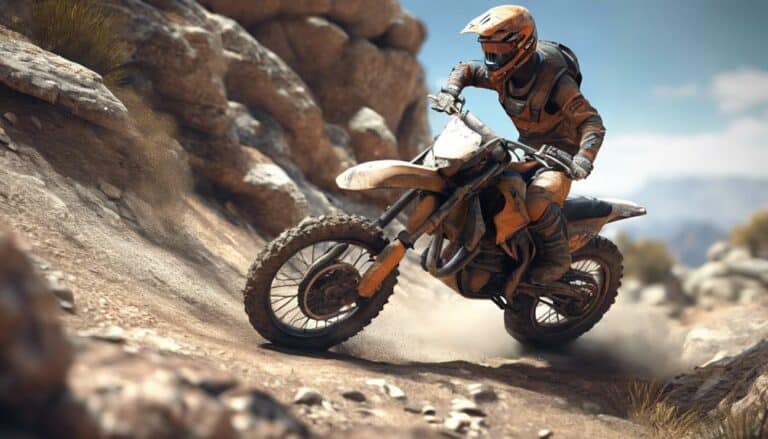When it comes to dirt bike riding, the type of terrain is like a maestro guiding your gear selection, orchestrating the harmony between your bike and the ground beneath.
Each twist and turn, each slope and obstacle, demands a thoughtful choice in gear ratios to navigate effectively.
But how exactly does the terrain influence your gear selection? Let's explore the intricate dance between dirt bikes and the varied landscapes they traverse, uncovering the secrets to mastering different terrains through gear selection.
Key Takeaways
- Terrain influences gear selection for traction, control, and maneuverability.
- Adjust gear ratios for rocky, muddy, sandy, and trail terrains.
- Lower gearing enhances stability, prevents wheel spin, and optimizes performance.
- Proper gear selection is vital for navigating various terrains with confidence and control.
Impact of Terrain on Gear Ratio
When considering the impact of terrain on gear ratio for dirt bike riding, gear selection plays a pivotal role in optimizing control, power delivery, and overall performance. The terrain you ride on directly influences the gear ratio needed to tackle various challenges effectively.
For instance, when handling tight, technical sections, lower gearing ratios are beneficial as they provide better control and maneuverability. In contrast, open, high-speed terrains like desert tracks demand higher gearing ratios to maximize top speed and performance.
Rocky or uneven terrains pose a different challenge, requiring gearing adjustments to enhance traction and power delivery. In such conditions, choosing the right gear ratio can make a significant difference in your riding experience. Similarly, when faced with muddy or slippery terrain, lower gearing becomes essential to maintain traction and prevent wheel spin, ensuring a smoother and more controlled ride.
Understanding how different terrains affect gear selection is important for optimizing your dirt bike's performance and your overall riding experience.
Gear Selection for Rocky Terrain
To optimize your dirt bike's performance on rocky terrain, selecting lower gearing with a larger rear sprocket or smaller front sprocket is essential for improved traction and control. Lower gearing helps navigate rocky obstacles at slower speeds, providing increased torque for better maneuverability.
When riding on rocky terrain, it's important to opt for a gear setup that allows for easier clutch modulation and throttle control to prevent wheel spin on the uneven surfaces. Adjusting gear ratios properly is key to maintaining consistent power delivery, which minimizes the risk of stalling or losing momentum on challenging rocky terrain.
By selecting the right gear ratios tailored to rocky terrain, you enhance your confidence as a rider, reduce the chance of bike damage, and ensure a smoother overall riding experience.
- Opt for a smaller rear sprocket or a larger front sprocket for improved traction.
- Lower gearing helps navigate rocky obstacles with increased torque.
- Ensure easier clutch modulation and throttle control to prevent wheel spin.
- Adjust gear ratios for consistent power delivery and minimized stalling risk.
Choosing Gear for Sand Riding
Considering the demands of sand riding, adjusting gear ratios for lower gearing is important to maximize traction and maneuverability in soft and loose terrain. In sand riding, the need for increased torque to power through the challenging surface is essential.
To achieve this, opting for a larger rear sprocket or a smaller front sprocket can help enhance performance. Lower gearing allows your dirt bike to maintain control and traction in the sandy conditions, preventing wheel spin and loss of momentum.
By selecting the appropriate gear ratios for sand riding, you can guarantee top performance and maneuverability on this demanding terrain. The adjustments made to the gearing system play a significant role in how effectively you can navigate the soft and shifting sands, providing you with the necessary power and control to conquer the challenges presented by sand riding.
Gear Considerations for Mud Terrain
For best traction and control in muddy terrain, selecting lower gearing with a larger rear sprocket or smaller front sprocket is essential. When gearing down for mud terrain, you enhance your dirt bike's performance greatly. Here are some key gear considerations for tackling muddy conditions:
- Prevent Wheel Spin: Lower gearing helps prevent wheel spin, ensuring you maintain traction and momentum even in the muddiest sections.
- Improve Handling: Adjusting your sprocket sizes for mud terrain improves low-end torque, making it easier to handle slippery surfaces and maintain control.
- Enhanced Stability: Proper gear selection in muddy conditions promotes stability, reducing the risk of getting stuck or losing control due to poor traction.
- Conquer Obstacles: Lower gearing allows you to confidently navigate obstacles in mud, providing a smoother and more controlled riding experience.
Gear Essentials for Trail Riding
When gearing up for trail riding, prioritize selecting lower gearing with a larger rear sprocket to optimize torque and control on challenging terrains. Lower gears provide faster acceleration and improved torque, essential for maneuvering steep inclines and technical obstacles commonly found on trails.
Pairing a larger rear sprocket with a smaller front sprocket helps achieve the desired gear ratio for trail riding, allowing you to maintain slower speeds for better power delivery and control. This setup enhances traction on loose surfaces and aids in maneuvering through tight sections with precision.
Conclusion
As you navigate the diverse terrains on your dirt bike, remember that your gear selection is important for optimizing performance.
Just like a skilled craftsman selecting the perfect tool for each task, choosing the right gear ratios tailored to the terrain is vital for a smooth and controlled ride.
So, gear up wisely, like a master painter choosing the perfect brush for a masterpiece, and conquer any terrain with precision and finesse.
Ride on, adventurer.

